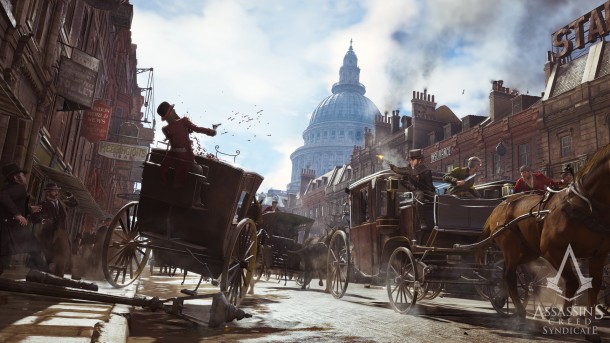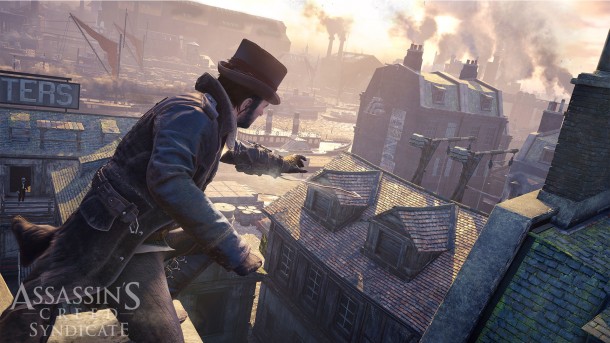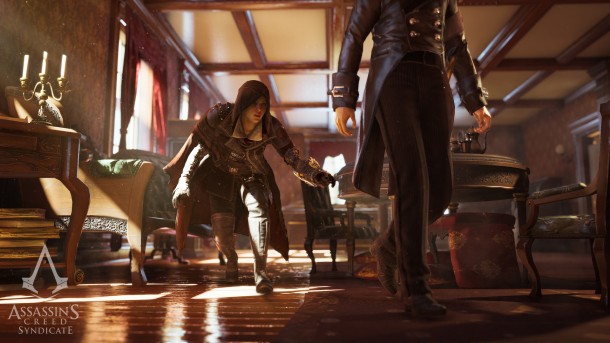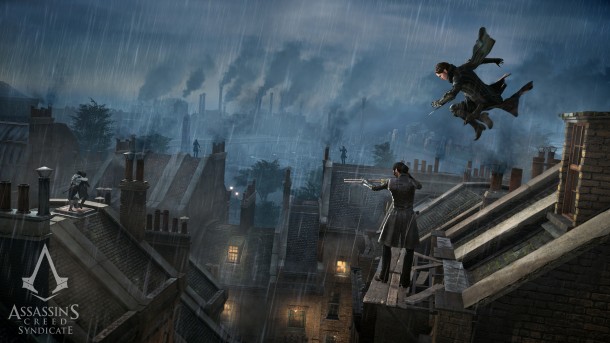Assassin’s Creed Syndicate overwhelms me. In those moments the most I can do is remain still, watch the ebb and flow of pedestrian and carriage traffic, and allow it all to soak in.
This reaction is primarily caused by Victorian London herself. While Assassin’s Creed has long been renowned for its historical world building, the franchise has somehow outdone itself with the Industrial Revolution. Both large and small details blur into one of the most lifelike settings in the series’ history. Soot-stained glass bears imperfections that speak of the newness of the technology which mass produced it. Walls are plastered with advertisements. The Thames is a surging, moving life-force brimming with boats and rubbish alike. As someone who has dedicated their educational career to studying Victorian London, this attention to detail electrifies me.
I can’t imagine a more fitting environment for the latest Assassin’s Creed title. Last year’s release of Unity was met with widespread criticism. Its wealth of technical issues led many to wonder whether the industrious franchise machine could continue churning out annual releases. Syndicate, conversely, possesses the same sort of optimism and eye for reform exhibited by the Victorians themselves. It polishes and refines what was once losing its luster; it also unabashedly paves the way for future entries, reassuring fans everywhere that Assassin’s Creed has all but run its course. The franchise machine is rolling onward, and Syndicate is both a highly effective and compelling cog in that engine.

Taking place during the 1860’s, Assassin’s Creed Syndicate tells the story of twin assassins Jacob and Evie Frye. They are intent on liberating the trodden-upon lower classes while wresting the power from the rich and corrupt. Of course, said “rich and corrupt” largely consists of the Templar Order, who have some prime real estate in London. Crawford Starrick, Grand Master of the British Rite and the game’s Big Bad, owns a large business empire in London and, therefore, has a finger poised on the pulse of the world.
It’s a simple enough premise, but Syndicate makes it interesting through good writing and an entertaining cast of characters. Starrick is less of a cardboard cut-out villain and more of a capital “C” character that Daniel Day-Lewis might play. While his villainy is at times overwrought, it’s no worse than the Borgias and every bit as memorable…and motivating.
Evie Frye and her brother are also great, and their plucky sibling banter adds a welcome touch of brevity. Evie is the older of the two twins; she is calculating, precise, and intelligent. Jacob is more brash and reckless, preferring to accomplish his goals through improvisation and fisticuffs. Both notably start off as already established assassins. This frees the plot from the repetition of past titles, which dealt with the titular assassin’s rise through the ranks. There’s even something of a modern day plot, and while it consists solely of cutscenes, it actually progresses the story.

As with any Assassin’s Creed title, the cast of historical allies is another major attraction. Evie and Jacob rub elbows with famous individuals like Charles Darwin, Florence Nightingale, and Charles Dickens. These characters primarily offer opportunities for side missions, which increase the player’s reputation with them. Levelling up reputation is a great way of unlocking new equipment, though interacting with these characters was incentive enough for me. A good example of this is Dickens himself, who has a prolific fascination with the supernatural (a historically accurate trait). His missions call for players to investigate Victorian legends such as the infamous Spring-heeled Jack or the haunted 50 Berkeley Square. Often, the historical references are rich and layered, even within something as seemingly inconsequential as a side-mission.
While there are no drastic changes to core gameplay, there are numerous refinements and additions to the mechanics which make a big impact. The first of these are the dynamic environments, which allow combat on moving trains and carriages. It is oddly appropriate that Syndicate’s greatest progress is played out atop locomotive engines—the epitome of progress for Victorian London. There’s nothing quite as exhilarating as leaping across train cars to fight combatants, and, of course, hijacking a carriage in London’s streets has its own allure. While the locomotives and carriages are admittedly wonderful, I am most grateful for what this technology has done for the River Thames region of the game. Knowing the history of the Thames is reason enough to never touch the water, but, luckily, there is a constant stream of boat traffic along the river. Navigating naval traffic—and the shifting environment it presents—tests both assassin and player reflexes alike. As a result, free running is more engaging on the Thames than it’s ever been in past games.
Even beyond the Thames, free running is absolutely fantastic in Assassin’s Creed Syndicate. For the first time in the series’ history, I didn’t feel like I was in a battle of wills against an assassin who compulsively climbed everything they could. The addition of ascent and descent buttons make free running a breeze, and while it’s still possible for an assassin to misbehave, the new controls very nearly do away with that old quibble.

Another notable addition to the mechanics and movement is the rope launcher, which is one of Syndicate’s absolute best features. A simple press of the button allows players to scale even the tallest building in a snap. Though I worried that the rope launcher would simplify climbing too much, it actually supplements it. Scaling viewpoints no longer involves looking around desperately for the next hand hold. Similarly, wide gaps between rooftops no longer impede horizontal movement across the city. This gear, when combined with the streamlined climbing mechanics, results in heightened mobility for the assassins. Free running is quick, sleek, and agile. That said, the rope launcher could use a touch more refinement, as it was sometimes difficult to tell what was being targeted.
Ubisoft turned a similar eye for progress towards Syndicate’s combat. Gone are the days of bearing down on a block button and waiting for an opponent to swing. Countering, admittedly, still plays an important role, but the emphasis here is on the offensive. Successful attacks build combo streaks, which move enemies to a near-death state more quickly. This is a system that favors quick-thinking and speed over slow and meticulously planned assaults.
The assassinations, meanwhile, cater to a variety of play styles and mark a return to form for the series. The game does not provide too much guidance in these segments; instead, players are left to complete the mission as they see fit. All assassinations begin with the assassin climbing a view point, observing their surroundings, and taking note of any visible opportunities. These “opportunities” may be perks which expedite an assassination, or they can reveal openings for unique assassinations, which are situational and depend on the target. Frankly, it’s hard for me to imagine anyone not springing for these unique assassinations. They are oddly charming (which is admittedly a strange descriptor for an assassination), and they offer a dynamism to the deed that the old approach-and-stab gameplay is unable to articulate. A great example of this is one of my favorite unique kills, which involved Evie swapping places with a cadaver in order to leap out from the shroud and dispose of the target during a medical lecture.
As always, there’s far more to do in the game than simply track down the next target. Assassin’s Creed continues its love affair with collectibles, and so there are pressed flowers, music boxes, beer brands, historical posters, and royal letters scattered about to haunt completionists and leave their fingers twitching. Viewpoints also make a triumphant return, and they serve as the world’s fast travel markers in addition to revealing other relevant points of interest.
The territory reclaiming feature from past games also plays a prominent role in Syndicate, though the story reasoning is rather different from past incarnations. Jacob Frye establishes a gang known as the Rooks, and this is done with the intent of ousting rival gang the Blighters from their reign (who also happen to be in Starrick’s pocket). In order to shake off the Blighter’s grasp on a district, players must complete certain tasks. These range from kidnapping specific targets to entirely clearing out a Blighter stronghold. If the player is successful, a small, puzzle-piece like region within the district has a decreased enemy presence. It also causes ally Rooks to appear in the world, who may be recruited for extra help if things get a bit hairy.
Of course, the more tasks players complete, the more attention they attract from the gang boss in that district. Successfully clearing a district culminates in gang warfare, which consists of open combat between the rival groups (and attracts quite a crowd of cheering onlookers). While this premise is engaging, the gang wars themselves often regress into tedium. The first leg of the conflict is straight forward: Jacob or Evie and a handful of Rooks square off against a few Blighters. Once those enemies are ousted, the fight becomes a one-on-one bout with the boss. Here’s where the gang warfare headed south for me: the boss occasionally is given an opportunity to wail on the assassin in an interactive cut scene, forcing players to time their counters or face a brutal depletion of health. These moments feel too much like QTE set-pieces to me, and if players fail to counter, then they’re jettisoned back to the first stage of the conflict.
The best way to avoid the frustration of gang warfare is to pay judicious attention to all of the unlockable skills in game. The Rooks have an array of unlockable skills which can increase cash flow or boost the efficacy of the NPC allies. Both Evie and Jacob Frye have a skill tree as well. Not only does this give the assassins an added edge in combat, but it also allows players to tailor the assassins to their specific playstyles. Naturally, I was invested in Evie from the start, and so I boosted the effectiveness of her throwing knives and grabbed every skill available on the Stealth skill tree. As a result, I had the most assassin-like playthrough that I’ve ever experienced. I felt like a shadow, flitting by enemies and quietly disposing of those that were unfortunate to stand in my path.
Just as Victorian London was the heart of the world, so too is Assassin’s Creed Syndicate the heart of what makes the franchise great. The free running and assassination mechanics are the best that they have ever been, and the ability to climb moving objects somehow makes the world feel even more life-like and dynamic. There are too many refinements to list within the scope of this review — little flourishes and details improve upon the old formula. Like gears in a machine, these little changes drive a much bigger picture: they were made deliberately with an eye for reinvigorating the franchise and paving the way for future entries. As a result of this conscientious approach, Assassin’s Creed Syndicate is easily one of the best entries in the series. It may have overwhelmed me, at times, with all it has to offer, but it also gives me great hope for the series’ future.
This review is based on a game code for the Xbox One provided by the developer.





No Comments